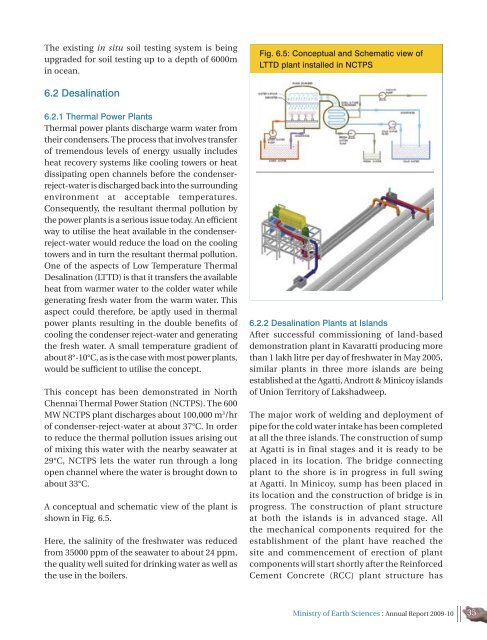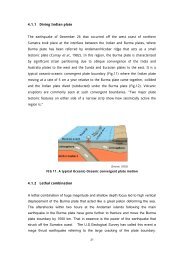Annual Report 2009-2010 - Ministry Of Earth Sciences
Annual Report 2009-2010 - Ministry Of Earth Sciences
Annual Report 2009-2010 - Ministry Of Earth Sciences
You also want an ePaper? Increase the reach of your titles
YUMPU automatically turns print PDFs into web optimized ePapers that Google loves.
The existing in situ soil testing system is being<br />
upgraded for soil testing up to a depth of 6000m<br />
in ocean.<br />
Fig. 6.5: Conceptual and Schematic view of<br />
LTTD plant installed in NCTPS<br />
6.2 Desalination<br />
6.2.1 Thermal Power Plants<br />
Thermal power plants discharge warm water from<br />
their condensers. The process that involves transfer<br />
of tremendous levels of energy usually includes<br />
heat recovery systems like cooling towers or heat<br />
dissipating open channels before the condenserreject-water<br />
is discharged back into the surrounding<br />
environment at acceptable temperatures.<br />
Consequently, the resultant thermal pollution by<br />
the power plants is a serious issue today. An efficient<br />
way to utilise the heat available in the condenserreject-water<br />
would reduce the load on the cooling<br />
towers and in turn the resultant thermal pollution.<br />
One of the aspects of Low Temperature Thermal<br />
Desalination (LTTD) is that it transfers the available<br />
heat from warmer water to the colder water while<br />
generating fresh water from the warm water. This<br />
aspect could therefore, be aptly used in thermal<br />
power plants resulting in the double benefits of<br />
cooling the condenser reject-water and generating<br />
the fresh water. A small temperature gradient of<br />
about 8°-10°C, as is the case with most power plants,<br />
would be sufficient to utilise the concept.<br />
This concept has been demonstrated in North<br />
Chennai Thermal Power Station (NCTPS). The 600<br />
MW NCTPS plant discharges about 100,000 m 3 /hr<br />
of condenser-reject-water at about 37°C. In order<br />
to reduce the thermal pollution issues arising out<br />
of mixing this water with the nearby seawater at<br />
29°C, NCTPS lets the water run through a long<br />
open channel where the water is brought down to<br />
about 33°C.<br />
A conceptual and schematic view of the plant is<br />
shown in Fig. 6.5.<br />
Here, the salinity of the freshwater was reduced<br />
from 35000 ppm of the seawater to about 24 ppm,<br />
the quality well suited for drinking water as well as<br />
the use in the boilers.<br />
6.2.2 Desalination Plants at Islands<br />
After successful commissioning of land-based<br />
demonstration plant in Kavaratti producing more<br />
than 1 lakh litre per day of freshwater in May 2005,<br />
similar plants in three more islands are being<br />
established at the Agatti, Andrott & Minicoy islands<br />
of Union Territory of Lakshadweep.<br />
The major work of welding and deployment of<br />
pipe for the cold water intake has been completed<br />
at all the three islands. The construction of sump<br />
at Agatti is in final stages and it is ready to be<br />
placed in its location. The bridge connecting<br />
plant to the shore is in progress in full swing<br />
at Agatti. In Minicoy, sump has been placed in<br />
its location and the construction of bridge is in<br />
progress. The construction of plant structure<br />
at both the islands is in advanced stage. All<br />
the mechanical components required for the<br />
establishment of the plant have reached the<br />
site and commencement of erection of plant<br />
components will start shortly after the Reinforced<br />
Cement Concrete (RCC) plant structure has<br />
<strong>Ministry</strong> of <strong>Earth</strong> <strong>Sciences</strong> : <strong>Annual</strong> <strong>Report</strong> <strong>2009</strong>-10 35

















